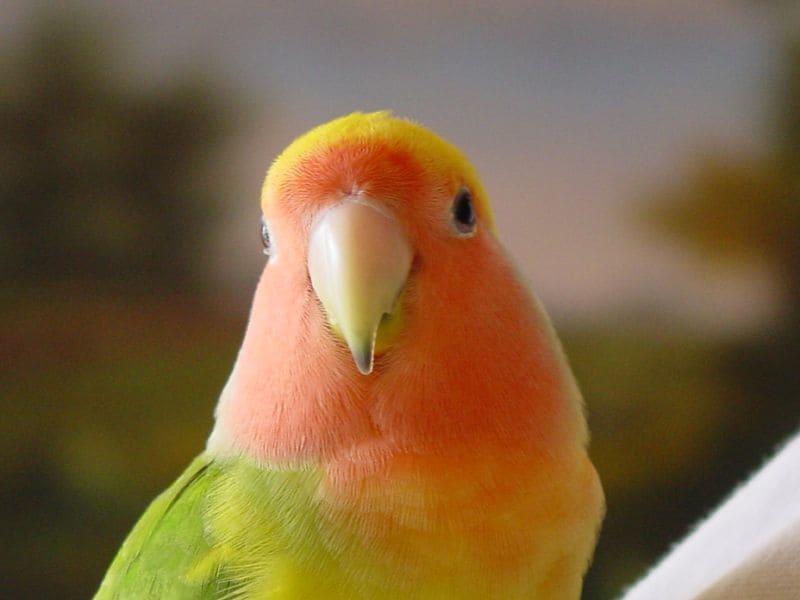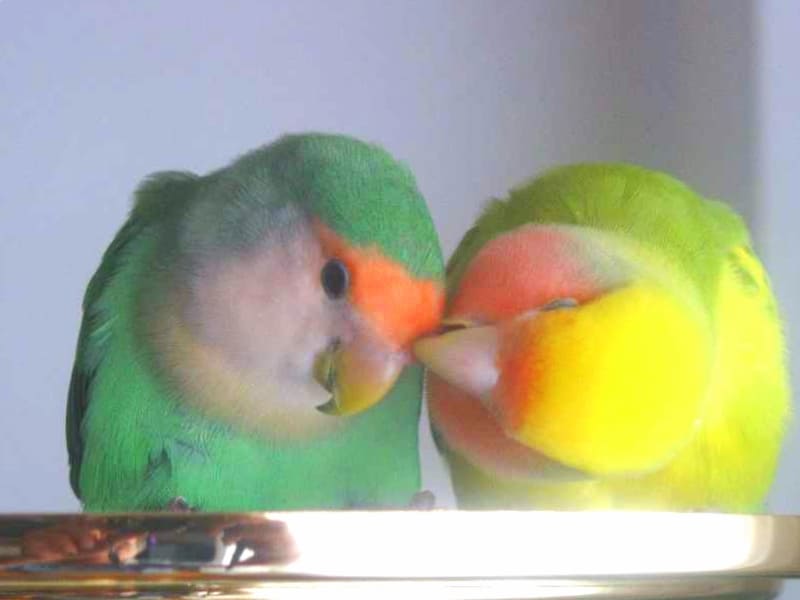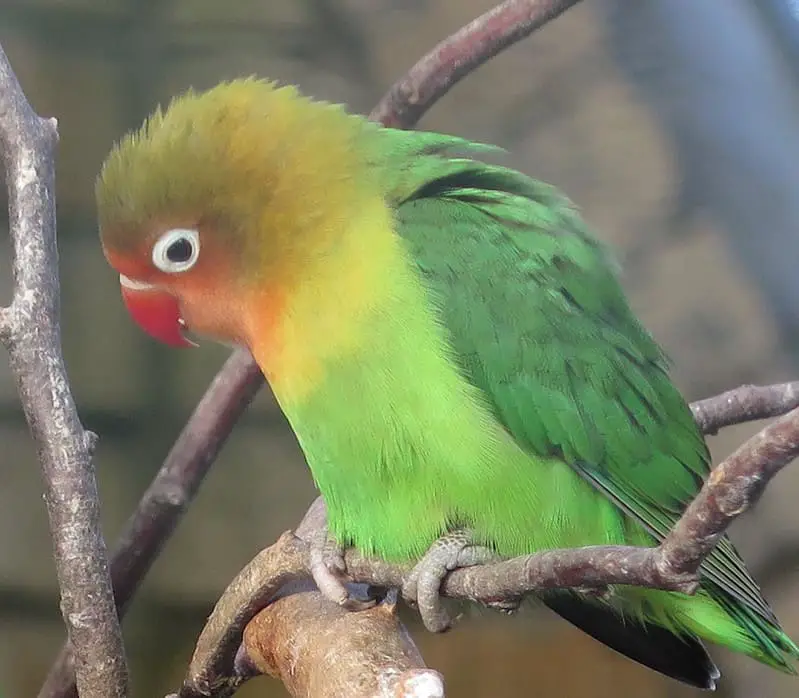Lovebirds, with their vibrant plumage and affectionate behavior, are popular pet birds known for forming strong bonds with their owners. However, beneath their charming exterior, lovebirds can sometimes display territorial and aggressive behavior, not only towards other birds but even towards their own kind. In this comprehensive article, we will explore the factors that contribute to lovebirds’ aggression, their interactions with other birds, and how to manage and prevent aggressive behavior in these small parrots.

Understanding Lovebirds
Before delving into the question of lovebird aggression towards other birds, it’s essential to understand these colorful and lively parrots. Lovebirds belong to the genus Agapornis and are native to the African continent. There are several species of lovebirds, but the most commonly kept as pets include the Peach-faced Lovebird, Fischer’s Lovebird, and the Masked Lovebird.
Lovebirds are known for their endearing and affectionate nature. They form strong pair bonds, often displaying their devotion through preening, cuddling, and feeding each other. These close relationships have led to their name, “lovebirds.” They are relatively small in size, measuring around 5 to 7 inches (13 to 17 cm) in length, with vibrant plumage in various colors.
Lovebirds’ Natural Behavior
In the wild, lovebirds are social birds that live in flocks. Their strong pair bonds extend to their interactions within the flock, where they often stick together with their chosen mate. Lovebirds are known for their playful and active nature, and their lives in the wild are marked by communal roosting, foraging, and even territorial disputes.
These natural behaviors can provide insight into why lovebirds sometimes exhibit aggression, not only towards other bird species but within their own species as well.
Factors Contributing to Lovebird Aggression
Several factors can contribute to lovebirds displaying aggressive behavior, both within their species and towards other birds:
1. Territorial Instinct
Lovebirds, like many parrot species, have a strong territorial instinct. In the wild, they defend their chosen nesting sites and foraging areas from intruders. This territorial nature can be seen in captivity, where lovebirds may become protective of their cage, nesting box, or specific perches. They may perceive other birds as threats to their territory, leading to aggressive behavior.
2. Jealousy
Lovebirds often form intense pair bonds, and when a pet owner introduces another bird into the household, it can trigger jealousy. Lovebirds may perceive the new bird as a rival for the attention and affection of their human caregiver, leading to aggressive behaviors aimed at the newcomer.
3. Hormonal Changes
Like many birds, lovebirds experience hormonal changes during their breeding season. These hormonal fluctuations can make them more irritable and prone to aggressive behaviors. Even without a mate, a lovebird may undergo hormonal changes, which can result in territorial aggression and even aggression towards their own reflection in mirrors or shiny objects.
4. Cage Size and Environment
The size of the cage and the quality of the environment can influence a lovebird’s behavior. Inadequate space or a lack of stimulation can lead to frustration and aggression. A crowded or poorly designed cage can create a stressful environment, which in turn may result in territorial aggression towards other birds.
5. Individual Personality
Just like humans, each lovebird has its unique personality. Some lovebirds may be naturally more aggressive or territorial than others. These individual differences can influence their interactions with other birds and their response to various stimuli.
6. Socialization
The early socialization of a lovebird can also play a role in their behavior. Birds that were not properly socialized as chicks may be more likely to exhibit aggressive tendencies towards other birds and people.

Aggression Towards Other Birds
Lovebirds can be territorial and sometimes aggressive towards other birds, especially if they perceive them as intruders. Whether the aggressor is a lone lovebird or a bonded pair, interactions with other birds, including those of different species, can be challenging.
Aggression Towards Other Lovebirds
- Intra-Species Aggression: Lovebirds, even those that have formed strong pair bonds, can exhibit intra-species aggression. This often occurs during the breeding season, as they become more protective of their nesting area and potential mates. In extreme cases, it can result in physical fights between lovebirds within the same cage.
- Introducing New Lovebirds: When introducing a new lovebird into an established pair’s territory, aggression is common. The resident lovebirds may perceive the newcomer as a threat to their bond and may engage in territorial disputes.
Aggression Towards Other Bird Species
- Interspecies Aggression: Lovebirds may display aggression towards other bird species, especially when sharing an aviary or living in proximity to other birds. They may view these neighboring birds as intruders and become defensive of their space.
- Territorial Behavior: Lovebirds can become territorial when they encounter other birds, regardless of their species. This territorial behavior can manifest as loud vocalizations, posturing, and attempts to drive away the perceived intruders.
- Bullying: In mixed-species aviaries, lovebirds have been observed engaging in bullying behavior towards smaller or more passive birds. This can lead to stress and aggression in the targeted birds.
Aggression Towards Pet Birds
Many bird enthusiasts keep multiple species of birds in the same household. When lovebirds share living spaces with other pet birds, potential conflicts can arise. Here are some scenarios:
- Cage Aggression: Lovebirds may become aggressive towards other pet birds when they are housed together in the same cage. This can result in injuries to both the lovebirds and the other birds.
- Out-of-Cage Interactions: Even if lovebirds and other pet birds have separate cages, they may still have interactions outside the cage. Aggression can occur during these interactions, and it’s essential to monitor their behavior closely.
- Territorial Behavior: Lovebirds may exhibit territorial behavior when they are near other birds, leading to confrontations during shared out-of-cage time.

Managing and Preventing Lovebird Aggression Towards Other Birds
Preventing and managing lovebird aggression towards other birds requires a combination of understanding their behavior, proper care, and environmental management. Here are some strategies to consider:
1. Separate Cages
If you have multiple pet birds, especially of different species, it is generally advisable to house them in separate cages. This minimizes the risk of territorial aggression and physical confrontations. Each bird should have its designated space, providing a safe retreat.
2. Supervised Interactions
When allowing lovebirds to interact with other birds outside their cage, supervision is crucial. This oversight can help prevent aggression and intervene if necessary. If you notice aggressive behavior, separate the birds immediately.
3. Individual Attention
If you have a lovebird that displays jealousy towards other birds, ensure that you continue to provide individual attention and bonding time. Reassure the lovebird that it is still a valued member of your flock.
4. Adequate Space
Providing a spacious and enriched environment is essential for preventing aggression in lovebirds. A larger cage with toys, perches, and mental stimulation can reduce frustration and territorial behaviors.
5. Regular Socialization
Proper socialization of lovebirds from a young age can help reduce aggressive tendencies. Hand-raised and well-socialized lovebirds tend to be more adaptable and less prone to aggression.
6. Monitoring Hormonal Changes
Be aware of the hormonal cycles in lovebirds, especially during the breeding season. Adjust their environment and interactions accordingly to minimize stress and aggression.
7. Professional Guidance
If you’re experiencing persistent or severe aggression issues with your lovebirds, consult with an avian veterinarian or an experienced avian behaviorist. They can provide tailored advice and strategies to address the specific challenges you’re facing.
8. Individualize Care
Remember that each lovebird has its personality and unique needs. Some lovebirds may be more prone to aggression than others, and it’s essential to adapt your care and management based on their individual traits.
Conclusion
Lovebirds, while known for their affectionate nature, can indeed display aggression towards other birds. This aggression can manifest as territorial behavior, jealousy, and sometimes physical confrontations. Understanding the factors that contribute to lovebird aggression and implementing appropriate strategies to prevent and manage it are essential for the well-being of both your lovebirds and other birds in your care.
By providing a suitable environment, individualized attention, and proactive monitoring of hormonal changes, you can help create a harmonious living situation for all the feathered members of your household. With the right care and precautions, lovebirds can coexist peacefully with other birds and continue to bring joy and companionship to their human caregivers.
